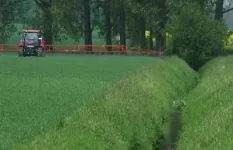Different general anesthetics affect consciousness and memory in different ways
Among typical anesthetics, only isoflurane results in undisrupted memory formation in mice
2021-04-01
(Press-News.org) Memory loss is common after general anesthesia, particularly for events occurring immediately before surgery--a phenomenon called retrograde amnesia. But a new study publishing on April 1st 2021 in the open access journal PLOS Biology, led by Simon Wiegert at the University Medical Center Hamburg-Eppendorf in Germany, shows that changes in the hippocampus--the part of the brain used to make new memories--differ depending on which general anesthetic is used. Consequently, their effects on memory formation also differ.
Understanding how different anesthetics affect the brain, particularly the hippocampus, is therefore important for both clinicians with human patients and experimental scientists who work with animals. Wiegert and his team recorded brain activity from the hippocampus while mice were anesthetized using one of three common combinations of general anesthetics: isoflurane, ketamine/xylazine (Keta/Xyl), and medetomidine/midazolam/fentanyl (MMF). Brain activity was recorded electrically and by optically imaging calcium flow--a dynamic signal indirectly reflecting neuronal activity and a trigger that allows brain cells to pass signals to each other.
Both recording methods showed that each drug changed brain activity in the hippocampus compared to wakefulness or natural sleep. The researchers found a number of differences in how the specific anesthetics affected the brain. For example, Keta/Xyl strongly reduced overall calcium activity, while MMF affected its rate much more than the duration. Furthermore, all anesthetics affected the stability of synaptic connections between brain cells in the hippocampus. Keta/Xyl disturbed synaptic stability most drastically, reflecting its strong disturbances of neuronal calcium activity. Recovery time also differed; brain activity returned to normal in about 45 minutes after isoflurane anesthesia, but it took close to 6 hours for the other two drugs. Similarly, the mice showed signs of retrograde amnesia after both Keta/Xyl and MMF anesthesia. But after isoflurane anesthesia--the condition, which showed the mildest disturbances compared to natural sleep--they could still remember what they had learned before the surgery. Knowing these varying effects on the hippocampus and memory formation should be useful for doctors or experimenters when considering which method to use.
Dr. Wiegert notes, "200 million general anesthesia are administered worldwide per year, and amnesia is a central part of it. So, we wondered how it affects the (mouse) hippocampus - a brain region essential for the formation of everyday memories. Surprisingly, the literature is scarce and inconsistent. Therefore, we teamed up with the group of Ileana Hanganu-Opatz and other collaborators to fill this knowledge-gap. Using a large array of experimental methods and developing a number of new analysis routines, we investigated the effects of common anesthetics on the hippocampus at levels ranging from synapses to cellular ensembles and on memory formation. We were surprised to find very distinct short- and long-term effects between the anesthetics used in this study, despite all of them fulfilling the same hallmarks of general anesthesia. Alterations of brain networks in the hippocampus were also different from those described in the neocortex. In summary, our study suggests that isoflurane should be the anesthetic of choice, if brain processes relevant for memory formation should not be disturbed."
INFORMATION:
Research article
Peer reviewed; Experimental study; Animals
In your coverage please use these URLs to provide access to the freely available articles in PLOS Biology:
http://journals.plos.org/plosbiology/article?id=10.1371/journal.pbio.3001146
Citation: Yang W, Chini M, Pöpplau JA, Formozov A, Dieter A, Piechocinski P, et al. (2021) Anesthetics fragment hippocampal network activity, alter spine dynamics, and affect memory consolidation. PLoS Biol 19(4): e3001146.
https://doi.org/10.1371/journal.pbio.3001146
Funding: This work was funded by the Deutsche Forschungsgemeinschaft (DFG, SPP1926, FOR2419/P6, SFB963/B8 to J.S.W., SPP 1665/Ha 4466/10-1/Ha4466/12-1, SFB 936/B5 to I.L.H.-O., SFB 936/B7 to F.M.), the European Research Council (ERC2016-StG-714762 to J.S.W., ERC-2015-CoG 681577 to I.L.H.-O.), the German Academic Exchange Service (DAAD, STG/19/5744091 to A.F.), and the Chinese Scholarship Council (CSC 201606210129 to W.Y.). The funders had no role in study design, data collection and analysis, decision to publish, or preparation of the manuscript.
Competing Interests: The authors have declared that no competing interests exist.
[Attachments] See images for this press release:

ELSE PRESS RELEASES FROM THIS DATE:
2021-04-01
Achuta Kadambi, an assistant professor at the UCLA Samueli School of Engineering, published a column in the journal Science about how medical devices can be fundamentally biased -- not just in dataset representation as has been widely reported, but from a deeper root: the laws of physics.
Kadambi described how the inherent physics behind medical devices could vary across race and gender. He cited several examples of potential physics-based bias. For example, recent research has shown that a pulse oximeter -- a medical device typically placed on a fingertip that uses infrared and light beams to measure oxygen saturation of the blood and the pulse rate -- is more likely to miss low levels in people with darker skin.
What motivated Kadambi to write this piece stemmed from ...
2021-04-01
A group of scientists from the University of Koblenz-Landau, Germany, has shown that for plants and insects the applied pesticide toxicity in agriculture has substantially increased between 2004 and 2016. In a paper published in the current issue of Science, the authors show that this pattern is even relevant in genetically modified (GM) crops that were originally designed to reduce pesticide impacts on the environment.
"We have taken a large body of pesticide use data from the US and have expressed changes of amounts applied in agriculture over time as changes in total applied pesticide toxicity," says lead author Ralf Schulz, professor for environmental sciences in Landau. "This provides a new view on the potential ...
2021-04-01
We know your cat's whiskers are handsome -- but you can't even see the cool part.
The base of the whisker, which is responsible for sending touch signals to the brain, is hidden inside the follicle, a deep pocket that embeds the whisker within the skin. Because this section of the whisker is obscured, understanding precisely how whiskers communicate touch to the brain has been a longstanding mystery.
In a new study, an interdisciplinary team of researchers at Northwestern University has developed the first mechanical simulation of the whisker inside the follicle. By combining their new model with new anatomical observations, the researchers discovered that when whiskers touch an object, they ...
2021-04-01
For the first time, researchers have discovered a way to obtain polarity and photovoltaic behavior from certain nonphotovoltaic, atomically flat (2D) materials. The key lies in the special way in which the materials are arranged. The resulting effect is different from, and potentially superior to, the photovoltaic effect commonly found in solar cells.
Solar power is considered a key technology in the move away from fossil fuels. Researchers continually innovate more efficient means to generate solar energy. And many of these innovations come from the world of materials research. ...
2021-04-01
Despite a reduction in the total amounts of pesticides used, the toxicity of commonly used pesticides to nontarget species, partially aquatic invertebrates and pollinators, has increased considerably in recent decades, according to a new study analyzing 25 years of pesticide use. This has been driven by the widespread use of highly toxic pyrethroid and neonicotinoid pesticides. The findings challenge claims suggesting that the overall environmental impacts of pesticide use have declined. The impacts of applied pesticides on humans and the environment are often based on comparisons of use rates (e.g., kilograms per hectare) or the total amounts used (e.g., kilograms per year). However, from an environmental perspective, these weight-based ...
2021-04-01
Technology can be biased, and its design can disadvantage certain demographic groups. While efforts to address bias and promote fairness in technologies are rapidly growing in a variety of technical disciplines, Achuta Kadambi argues that similar growth is not occurring fast enough for medical engineering. "Although computer science companies terminate lucrative but biased facial recognition systems, biased medical devices continue to be sold as commercial products," writes Kadambi in a Perspective. Bias in medical devices results in undesirable performance variation across demographic groups and can greatly influence health inequality. For example, optical biosensors that use light to monitor vital signs like blood oxygenation ...
2021-04-01
In an analysis of thousands of fossil pollen and leaves spanning the Cretaceous-Paleogene (K/Pg) boundary, researchers found that the cataclysmic asteroid impact that resulted in the destruction of nearly 75% of all terrestrial life on Earth drastically restructured tropical forests, setting the stage for the evolution of what has become one of the planet's most diverse ecosystems - the neotropical rainforest. While the end-Cretaceous impact nearly 66 million years ago was catastrophic for terrestrial ecosystems worldwide, its long-term effects on tropical forests have remained a mystery. This is largely due to the lack of palaeobotanical exploration in the region, which has only just begun to provide ...
2021-04-01
An increase of dopamine in the brain's striatum triggers auditory hallucination-like experiences in mice, revealing a possible causal role for dopamine-dependent neurological circuits in symptoms of psychosis. These findings from a new study could inform novel targeted approaches to treating those with psychotic disorders, like schizophrenia. Auditory and visual hallucinations - perceptions of hearing or seeing something without observing external sensory stimuli - are central symptoms of psychotic disorders and are thought by some to be caused by excessive dopamine ...
2021-04-01
A single "super photon" made up of many thousands of individual light particles: About ten years ago, researchers at the University of Bonn produced such an extreme aggregate state for the first time and presented a completely new light source. The state is called optical Bose-Einstein condensate and has captivated many physicists ever since, because this exotic world of light particles is home to its very own physical phenomena. Researchers led by Prof. Dr. Martin Weitz, who discovered the super photon, and theoretical physicist Prof. Dr. Johann Kroha have returned from their latest "expedition" into the quantum world with a very special observation. They report of a new, previously ...
2021-04-01
(Santa Barbara, Calif.) -- Despite the fact that our planet is mostly ocean and human maritime activity is more intense than it has ever been, we know remarkably little about the state of the ocean's biodiversity -- the variety and balance of species that support healthy and productive ecosystems. And it's no surprise -- marine biodiversity is complex, human impacts are uneven, and species respond differently to different stressors.
"It is really hard to know how a species is doing by just looking out from your local coast, or dipping underwater on SCUBA," said Ben Halpern, a marine ecologist at the Bren School of Environmental Science & Management at UC Santa ...
LAST 30 PRESS RELEASES:
[Press-News.org] Different general anesthetics affect consciousness and memory in different ways
Among typical anesthetics, only isoflurane results in undisrupted memory formation in mice




